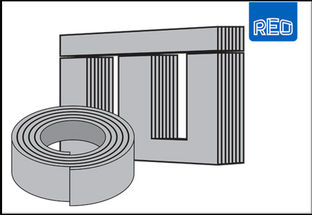What are the differences between toroidal transformers and conventional transformers?
Toroidal transformers and regular stacked lamination transformers (or EI transformers) differ in design and performance. Understanding the differences between these two types of transformers is essential for choosing the right one for your specific application.
The main significant difference lies in their physical structure. Toroidal transformers feature a toroid-shaped core made of a continuous loop of magnetic material. In contrast, regular transformers have a laminated core consisting of stacked layers to form the core; these laminations differ in thickness and are insulated from each other to reduce eddy current losses.
In toroidal transformers, the primary and secondary are wound over one another, with a layer of insulating material electrically separating them; with conventional stacked lamination transformers, the winding is usually made on a nylon bobbin, which is then assembled onto the core once it has been wound.
The unique design of toroidal transformers offers several advantages. Firstly, they exhibit lower electromagnetic interference (EMI) due to their compact shape and reduced magnetic flux leakage; this makes them ideal for applications where EMI needs to be minimized, such as audio equipment or sensitive electronic devices.
Additionally, toroidal transformers are more efficient than regular transformers. Their circular configuration allows for a shorter magnetic path length, reducing energy losses during power transfer. This efficiency translates into lower operating temperatures and increased overall reliability.
On the other hand, regular transformers are more commonly found in general-purpose applications due to their cost-effectiveness and versatility. The laminated core design provides ease of manufacturing and allows for different core shapes and sizes to suit various power requirements; they are usually done to larger control cabinets and equipment often used for providing a Separate Extra-Low Voltage (SELV) supply for control equipment to ensure safety.
In terms of size and weight, regular, open-wound toroidal transformers tend to be smaller and lighter compared to EI transformers with similar power ratings; for example, a typical 100 VA toroidal transformer will have a volume of approx 312 square centimeters, approximately half of the corresponding EI transformer. This compactness makes them suitable for space-constrained installations or portable devices where size matters.
Ultimately, the choice between toroidal and regular transformers depends on your needs and priorities. A toroidal transformer may be the preferred option if you require high efficiency, low EMI emissions, compact size, or special considerations regarding noise-sensitive applications, for example in high-end audio applications, however, a regular transformer would suffice if cost-effectiveness and versatility are key factors.
By understanding these distinctions comprehensively, you will be equipped to make an educated choice when selecting the most appropriate transformer type for your specific application needs.










